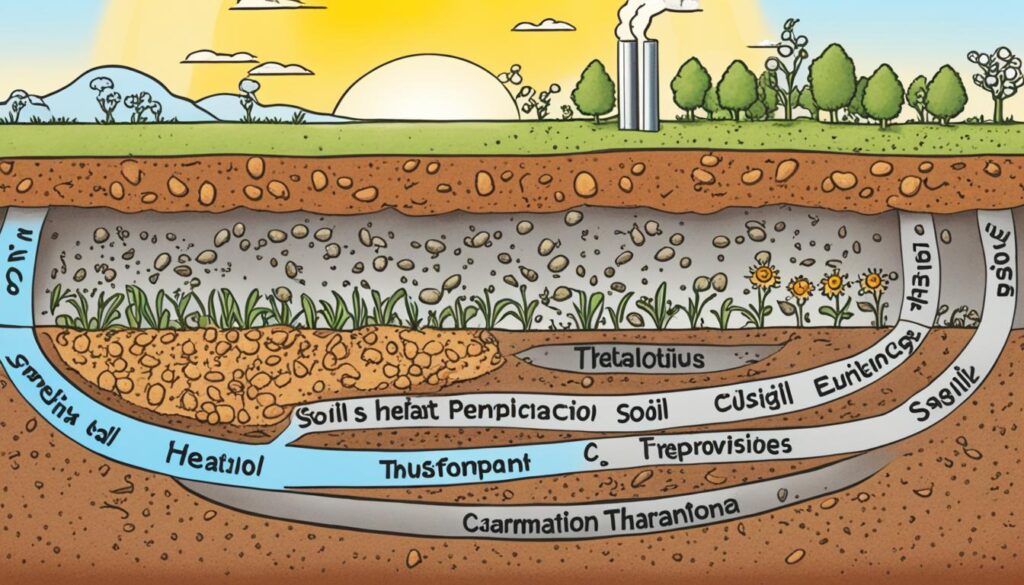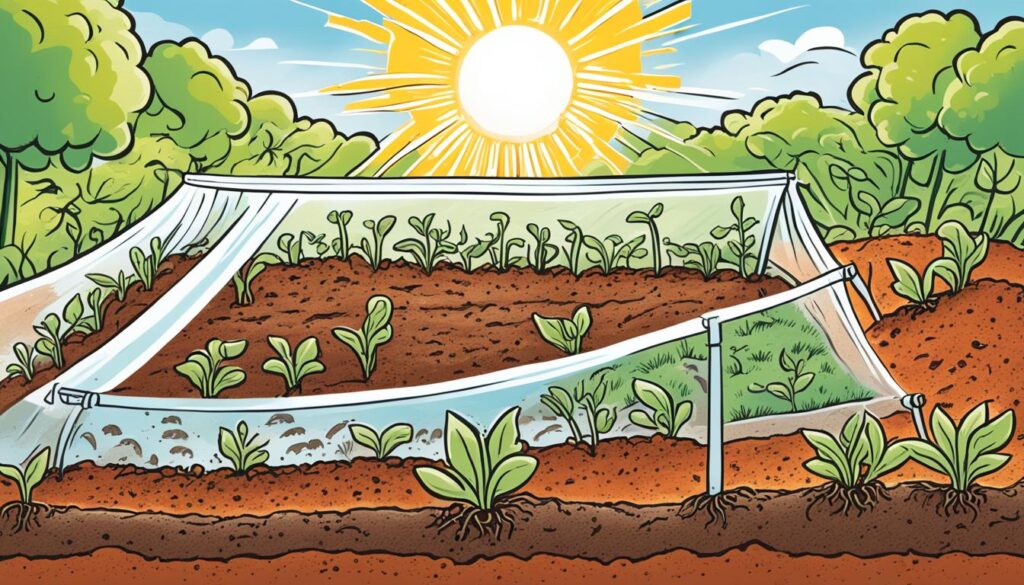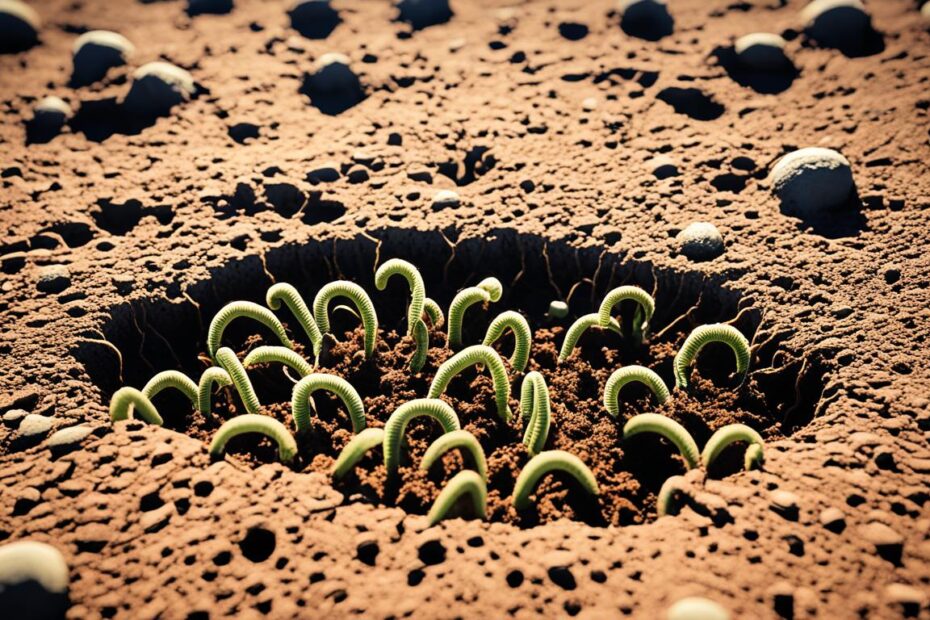When it comes to ensuring the health and productivity of your garden ecosystems, solving one problem can sometimes lead to another. Take soil solarization, for example. This nonchemical method used by organic gardeners to control weeds and soilborne pests has gained popularity for its effectiveness. But here’s the burning question: does soil solarization kill worms?
You may be surprised to learn that worms are resilient creatures that can wiggle away from the heat during the soil solarization process. So, what impact does this method have on earthworm populations? And how does it affect the overall balance of your garden soil?
Key Takeaways:
- Soil solarization does not kill worms.
- Worm populations can actually thrive in soil that has been solarized.
- Solarization effectively controls weeds, plant pathogens, and nematodes.
- The process improves soil health and nutrient availability.
- Using solarization in organic gardening practices can lead to higher yields without chemical pesticides.
How Does Solarization Work?
Solarization is an effective and environmentally friendly method used for weed control, disease control, and soil improvement in organic gardening. By harnessing the power of the sun’s radiant energy, gardeners can create a hostile environment for pests while promoting the breakdown of organic matter and releasing beneficial nutrients into the soil.
Here’s a step-by-step breakdown of the solarization process:
- Prepare the soil: Start by removing any existing plant matter from the area you wish to solarize. This includes weeds, debris, and crop residues. Next, use a garden rake or tiller to smooth the soil surface, creating a level bed.
- Moisten the soil: Before laying the plastic covering, it’s important to moisten the soil thoroughly. This helps to improve heat conduction and ensures an effective solarization process.
- Apply the plastic cover: Lay a clear plastic sheet over the moist soil, making sure it completely covers the area to be solarized. Secure the edges of the plastic by burying them in the soil, creating a seal to prevent heat escape.
- Maintain high temperatures: The key to successful solarization is to maintain high temperatures in the top 6 inches of soil. The recommended temperature is at least 110 degrees Fahrenheit. This lethal temperature range effectively kills weeds, plant pathogens, and nematodes present in the soil.
- Promote organic matter breakdown: As the soil heats up under the plastic cover, the solarization process accelerates the breakdown of organic matter. This breakdown releases essential nutrients such as nitrogen, calcium, magnesium, potassium, and fulvic acid, which are beneficial for plant growth.

The solarization process can be a highly effective and sustainable method for controlling weeds and diseases, as well as improving soil health. It is a natural alternative to chemical pesticides, making it a preferred choice for organic gardeners.
What Pests Does Solarization Control?
Solarization is a highly effective method for controlling a wide range of pests in the soil. It offers a nonchemical approach to pest management, making it an ideal choice for organic gardeners. Solarization can effectively control fungal diseases, bacterial diseases, nematodes, and weeds.
When it comes to fungal diseases, solarization can target various types, including Verticillium wilt, Fusarium wilt, Phytophthora root rot, and tomato canker. The elevated soil temperatures during the solarization process help eliminate these pathogens, reducing the risk of disease outbreaks in your garden.
In addition to fungal diseases, solarization is also effective against bacterial diseases. The heat generated by solarization can kill bacteria and prevent the spread of diseases such as bacterial wilt or blight, promoting healthier plants and better crop yields.
Nematodes are another common pest that can be controlled through solarization. This method reduces the populations of many nematode species, decreasing their negative impact on plant health. However, it’s important to note that nematodes have the ability to move deeper into the soil to escape the heat. They may recolonize the soil later, so continued monitoring and additional pest management strategies may be necessary.
Furthermore, solarization is an effective tool for weed control. It can target both annual and perennial weeds, minimizing their presence in the garden. While most weed species are susceptible to solarization, it’s worth noting that some weeds may be more resistant to the process.
The effectiveness of solarization in controlling pests can vary depending on factors such as the intensity, depth, and duration of the elevated soil temperatures. It’s important to follow proper solarization techniques and monitor the results to ensure optimal pest control.
Overall, solarization offers a comprehensive solution for managing fungal diseases, bacterial diseases, nematodes, and weeds. By incorporating this method into your gardening practices, you can create a healthier and more productive garden environment.
Note: The table below provides a summary of the pests that can be controlled through solarization.
| Pest | Controlled by Solarization |
|---|---|
| Fungal Diseases | Yes |
| Bacterial Diseases | Yes |
| Nematodes | Yes, with some limitations |
| Weeds | Yes, with varying degrees of effectiveness |
Benefits of Solarization
In addition to effective pest control, soil solarization offers numerous benefits for soil health and plant growth. By harnessing the power of the sun’s heat, this environmentally friendly method enhances nutrient availability, increases yields, and promotes the growth of beneficial microorganisms.
Promotes Soil Health
Soil solarization plays a crucial role in improving soil health by increasing the availability of essential nutrients. As the solarization process heats up the soil, it enhances the breakdown of organic matter and releases vital nutrients such as nitrogen, calcium, magnesium, potassium, and fulvic acid. This nutrient enrichment provides plants with the fuel they need for robust growth and optimal health.
Boosts Nutrient Availability
The increased availability of nutrients resulting from soil solarization has a direct positive impact on plant growth and development. With a nutrient-rich soil, plants have ample resources to support their physiological processes, which leads to faster growth and improved overall health. As a result, gardeners can achieve higher yields and cultivate thriving plantations.
Promotes Beneficial Microorganisms
“Soil solarization creates an environment that fosters the growth of beneficial microorganisms, such as mycorrhizal fungi.”
Beneficial microorganisms, such as mycorrhizal fungi, play a crucial role in enhancing plant vitality and resilience. These microorganisms form symbiotic relationships with plant roots, facilitating nutrient absorption and providing protection against pathogenic microorganisms. The solarization process promotes the growth and activity of these vital allies, allowing plants to develop stronger immune systems and resist harmful pathogens.
Environmentally Friendly Pest Control
One of the greatest advantages of soil solarization is its environmentally friendly nature. Unlike chemical pesticides, solarization leaves no chemical residues in the soil, ensuring a safer and more sustainable approach to pest control. This method harnesses natural energy to create a hostile environment for pests while preserving the delicate balance of the ecosystem.
| Benefits of Soil Solarization | Explanation |
|---|---|
| Promotes Soil Health | Increases nutrient availability and enhances organic matter breakdown. |
| Boosts Nutrient Availability | Provides plants with essential nutrients for faster growth and higher yields. |
| Promotes Beneficial Microorganisms | Fosters the growth of mycorrhizal fungi for enhanced plant resilience. |
| Environmentally Friendly Pest Control | Leaves no chemical residues in the soil, ensuring a safe and sustainable approach. |
The beneficial effects of soil solarization extend beyond pest control, enriching the soil, promoting plant growth, and nurturing beneficial microorganisms. By embracing this natural method, gardeners can cultivate healthy and vibrant gardens while minimizing their impact on the environment.

Conclusion
Soil solarization is a game-changer when it comes to pest control in organic gardening. By harnessing the power of the sun, this nonchemical method effectively eliminates weeds, fungal and bacterial diseases, nematodes, and other troublesome pests that can wreak havoc on your garden. Unlike chemical pesticides, soil solarization poses no harm to earthworms and beneficial microorganisms, making it a sustainable and eco-friendly approach.
But the benefits of soil solarization go beyond pest control. This technique also contributes to overall soil health and fertility. The high temperatures generated during solarization break down organic matter, releasing essential nutrients like nitrogen, calcium, magnesium, and potassium. This nutrient-rich soil provides a perfect environment for plants to thrive, resulting in increased yields and healthier crops.
By integrating soil solarization into your organic gardening practices, you can achieve superior pest management without relying on harmful chemicals. Not only does this approach promote sustainable gardening, but it also ensures that your produce is free from chemical residues, making it a safer and healthier option for you and your family. So why compromise on the health of your garden and the planet? Embrace soil solarization and reap the benefits of an organic garden that flourishes naturally.
FAQ
Does soil solarization kill worms?
No, soil solarization does not kill worms. Worms have the ability to wiggle away from the heat generated during the process and are not negatively impacted. In fact, worm populations can thrive in soil that has been solarized.
How does solarization work?
Solarization involves covering the soil with clear plastic to trap the sun’s radiant energy. This process heats the soil to high temperatures, effectively killing weeds, plant pathogens, and nematodes. The soil is prepared by removing plant matter and smoothing the bed, then moistened to improve heat conduction. Clear plastic is laid over the soil, creating a seal by burying the edges. The goal is to maintain a daily temperature of at least 110 degrees Fahrenheit in the top 6 inches of soil.
What pests does solarization control?
Solarization is effective in controlling a wide range of pests. It can control fungal and bacterial diseases such as Verticillium wilt, Fusarium wilt, Phytophthora root rot, and tomato canker. It also reduces populations of many species of nematodes and controls many annual and perennial weeds. However, some weed species may be more resistant to the process, and nematodes can move deeper in the soil to escape the heat and recolonize the soil later.
What are the benefits of solarization?
Solarization offers several benefits for the soil and plants. It improves soil health by increasing the availability of nutrients such as nitrogen, calcium, magnesium, potassium, and fulvic acid. This can result in faster plant growth and higher yields. Solarization also promotes the growth of beneficial microorganisms, such as mycorrhizal fungi, that help plants resist pathogens. Additionally, the process leaves no chemical residues and is a simple and environmentally friendly method of pest control.
